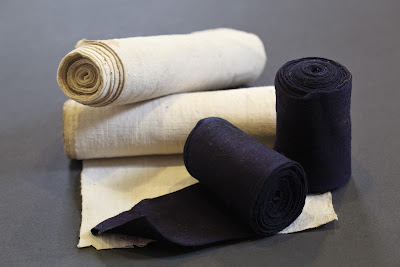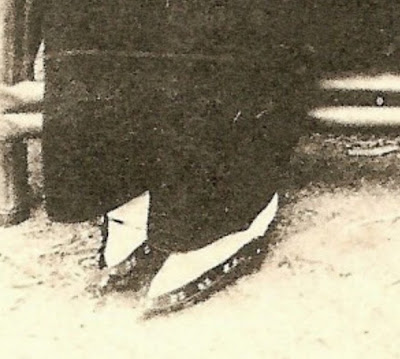Foot binding, also known as "lotus feet" is the custom of applying painfully tight binding to the feet of young girls to prevent further growth. The practice possibly originated among upper-class court dancers during the five dynasties and ten kingdoms period in imperial China (10th or 11th century), but spread in the Song Dynasty and eventually became common among all but the lowest of classes. Foot binding became popular as a means of displaying status (women from wealthy families who did not need them to work could afford to have their feet bound) and was correspondingly adopted as a symbol of beauty in Chinese culture.
The Manchu Emperor Kangxi of Qing dynasty tried to ban foot binding in 1664 but failed. In the 1800s (19th century), Chinese reformers challenged the practice but it was not until the early 20th century that foot binding began to die out, partly from changing social conditions and partly as a result of anti-foot binding campaigns. There were also edicts that attempted to ban foot binding. The Empress Dowager Cixi, a Manchu, issued such an edict following the Boxer Rebellion in order to appease foreigners, but it was rescinded a short time later. Foot binding was also outlawed in 1902 by the imperial edicts of the Qing Dynasty. In 1912, after the fall of the Qing Dynasty, the new nationalist government of the Republic of China banned foot binding, though, like its predecessors, not always successfully.
Bound feet were once considered intensely erotic in Chinese culture and became a mark of beauty and was also a prerequisite for finding a husband. A woman with perfect lotus feet was likely to make a more prestigious marriage, and became an avenue for poorer women to marry into money.
Qing Dynasty sex manuals had listed 48 different ways of playing with women's bound feet. Some men preferred never to see a woman's bound feet, so they were always concealed within tiny "lotus shoes" and wrappings. It is believed that if you remove the shoes and bindings, the aesthetic feeling will be destroyed forever, which is an indication that men understood that the symbolic erotic fantasy of bound feet did not correspond to its unpleasant physical reality, which was therefore to be kept hidden. The fact that the bound foot was concealed from men's eyes was considered to be sexually appealing. On the other hand, an uncovered foot would also give off a foul odour, as various saprobic microorganisms would colonize the unwashable folds.
For men, the primary erotic effect was a function of the lotus gait, the tiny steps and swaying walk of a woman whose feet had been bound. Women with such deformed feet avoided placing weight on the front of the foot and tended to walk predominantly on their heels. As a result, women who underwent foot-binding walked in a careful, cautious, and unsteady manner. Additionally a common male fantasy was that the unusual gait tended to strengthen the vaginal muscles.
An attribute of a woman with bound feet was the limitation of her mobility, and therefore, her inability to take part in politics, social life and the world. Bound feet rendered women dependent on their families, particularly their men, and became an alluring symbol of chastity and male ownership, since a woman was largely restricted to her home and could not venture far without an escort or the help of watchful servants.
Foot-binding resulted in lifelong disabilities for most of its subjects, and some elderly Chinese women still survive today with disabilities related to their bound feet.
 Picture 1
Picture 1
Two pairs of bandages or binding cloths for the foot binding process. The bandages were repeatedly wound in a figure-eight movement, starting at the inside of the foot at the instep, then carried over the toes, under the foot and around the heel. The freshly broken toes will be pressed tightly into the sole of the foot. At each pass around the foot, the binding cloth was tightened, pulling the ball of the foot and the heel together, causing the broken foot to fold at the arch and pressing the toes underneath.
 Picture 1
Picture 1
A pair of silk satin bed slippers. Because the bindings were never removed, regular shoes were replaced with soft sleeping slippers like this upon retiring for the night.
The Manchu Emperor Kangxi of Qing dynasty tried to ban foot binding in 1664 but failed. In the 1800s (19th century), Chinese reformers challenged the practice but it was not until the early 20th century that foot binding began to die out, partly from changing social conditions and partly as a result of anti-foot binding campaigns. There were also edicts that attempted to ban foot binding. The Empress Dowager Cixi, a Manchu, issued such an edict following the Boxer Rebellion in order to appease foreigners, but it was rescinded a short time later. Foot binding was also outlawed in 1902 by the imperial edicts of the Qing Dynasty. In 1912, after the fall of the Qing Dynasty, the new nationalist government of the Republic of China banned foot binding, though, like its predecessors, not always successfully.
Bound feet were once considered intensely erotic in Chinese culture and became a mark of beauty and was also a prerequisite for finding a husband. A woman with perfect lotus feet was likely to make a more prestigious marriage, and became an avenue for poorer women to marry into money.
Qing Dynasty sex manuals had listed 48 different ways of playing with women's bound feet. Some men preferred never to see a woman's bound feet, so they were always concealed within tiny "lotus shoes" and wrappings. It is believed that if you remove the shoes and bindings, the aesthetic feeling will be destroyed forever, which is an indication that men understood that the symbolic erotic fantasy of bound feet did not correspond to its unpleasant physical reality, which was therefore to be kept hidden. The fact that the bound foot was concealed from men's eyes was considered to be sexually appealing. On the other hand, an uncovered foot would also give off a foul odour, as various saprobic microorganisms would colonize the unwashable folds.
For men, the primary erotic effect was a function of the lotus gait, the tiny steps and swaying walk of a woman whose feet had been bound. Women with such deformed feet avoided placing weight on the front of the foot and tended to walk predominantly on their heels. As a result, women who underwent foot-binding walked in a careful, cautious, and unsteady manner. Additionally a common male fantasy was that the unusual gait tended to strengthen the vaginal muscles.
An attribute of a woman with bound feet was the limitation of her mobility, and therefore, her inability to take part in politics, social life and the world. Bound feet rendered women dependent on their families, particularly their men, and became an alluring symbol of chastity and male ownership, since a woman was largely restricted to her home and could not venture far without an escort or the help of watchful servants.
Foot-binding resulted in lifelong disabilities for most of its subjects, and some elderly Chinese women still survive today with disabilities related to their bound feet.
Two pairs of bandages or binding cloths for the foot binding process. The bandages were repeatedly wound in a figure-eight movement, starting at the inside of the foot at the instep, then carried over the toes, under the foot and around the heel. The freshly broken toes will be pressed tightly into the sole of the foot. At each pass around the foot, the binding cloth was tightened, pulling the ball of the foot and the heel together, causing the broken foot to fold at the arch and pressing the toes underneath.
A pair of silk satin bed slippers. Because the bindings were never removed, regular shoes were replaced with soft sleeping slippers like this upon retiring for the night.

